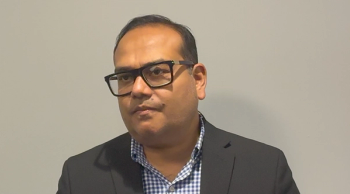
Oncology NEWS International
- Oncology NEWS International Vol 4 No 3
- Volume 4
- Issue 3
Caveats on Stereotactic Core Biopsy Use
SAN ANTONIO--Unresolved questions about accuracy and cost should limit the role of stereotactic core biopsy in breast cancer to low-suspicion lesions and a few other specific indications, advised Monica Morrow, MD, associate professor of surgery and director of clinical breast programs, Northwestern University Medical School.
SAN ANTONIO--Unresolved questions about accuracy and cost shouldlimit the role of stereotactic core biopsy in breast cancer tolow-suspicion lesions and a few other specific indications, advisedMonica Morrow, MD, associate professor of surgery and directorof clinical breast programs, Northwestern University Medical School.
Recent assertions that stereotactic core biopsy has supplantedsurgical excision appear to be premature, based on close inspectionof available data about the purported accuracy of the technique,its ability to characterize malignant lesions, and its cost vis-a-vissurgical excision, Dr. Morrow said at the closing plenary sessionof the San Antonio Breast Cancer Symposium.
Moreover, she claims, the increase in use of core biopsy in thepast several years has occurred in the absence of clinical standardsand credentialing procedures. "The ability to buy one ofthe machines does not necessarily mean that one knows how to useit," she said.
Still other concerns surround the role of the radiologist as theprimary care physician. Responsibility for communicating withpatients, counseling on treatment, and ensuring mammographic follow-upremain unresolved, she said.
With those caveats, Dr. Morrow believes that stereotactic corebiopsy is an important diagnostic technique whose usefulness stilllies mostly in the future.
How Accurate?
In the November, 1994, issue of Radiology, a report on 20 institutions'experience with core biopsy revealed a 0.2% miss rate for breastmalignancies. On that basis, the authors concluded that core biopsyis ready to replace surgical excision as the method of choicefor evaluating breast lesions.
Dr. Morrow questioned the conclusions on a number of counts. Ofthe more than 6,000 cases in the report, only 1,336 (22%) hadsurgical confirmation of the core biopsy. Of 173 lesions classifiedfor the purposes of the study as "mammary intraepithelialhyperplasia," a third had diagnostic discrepancies. Mostdisturbing to her, 15 of 280 benign lesions proved to be malignant,a 4% miss rate. The 0.2% error rate applied to the total numberof cases.
Problems also arise with core biopsy's ability to characterizemalignant lesions. In particular, Dr. Morrow said, core biopsydoes not adequately identify atypical hyperplasia or ductal carcinomain situ (DCIS).
"If you look in the literature, you will find there is abouta 20% incidence of invasive carcinoma in lesions that are calledDCIS and a 15% incidence of malignancy in lesions initially calledatypia," she said. Of malignancies diagnosed by mammography,anywhere from 30% to 50% are DCIS. In mammographic series, atypicalhyperplasia accounts for 10% to 20% of lesions excised. "Failureto diagnose these is not an insubstantial problem," she said.
Use of frozen-section analysis does not overcome the problems,Dr. Morrow continued. Available evidence suggests difficulty indistinguishing atypical hyperplasia from DCIS and DCIS from areasthat have a small amount of invasion.
The cost-savings potential of core biopsy depends not only onthe procedure's accuracy but also on the physician's practicestyle. Dr. Morrow cited data from Baylor University Medical Center,Dallas, wherein a third of 114 core biopsies of high-suspicionabnormalities revealed benign lesions or resulted in inadequatesampling. In each case, the abnormality subsequently was excisedor biopsied a second time.
Core biopsy's cost effectiveness for high-suspicion lesions restsgreatly on the role of breast-conserving surgery, she said. Ifall small malignant lesions detected by core biopsy are treatedwith mastectomy, then core biopsy will save money. The cost-effectivenessis less clear for breast conservation.
"If you do a high percentage of breast conservation surgeries,you will take the patient back to the radiology suite, put inthe same localizing wire you would have done in the first place,and do your lumpectomy," Dr. Morrow explained. "If youare concerned about your margins, you may rely on a frozen section.We know that 3% of patients optimally selected for breast conservationturn out to have extensive cancer, and they will return to theoperating room."
Stereotactic core biopsy will undoubtedly cost more if used indiscriminatelyfor clearly benign mammographic abnormalities. Lesions with lessthan 2% risk of malignancy can be followed by interval mammography,Dr. Morrow said.
Core biopsy likely will be cost effective for low- to intermediate-suspicionlesions that otherwise would be sent for surgical biopsy but thathave low cancer yields, she said. The table lists the situationsfor which Dr. Morrow believes the technique is most useful.
Dr. Morrow expressed concern about continuity of care when theradiologist serves as the cancer patient's primary physician."Complications are infrequent, but they do occur," shesaid. "Who communicates diagnostic results to the patientand provides counseling about treatment options? Who is responsiblefor ensuring that mammographic follow-up is carried out?"
She insists that before stereotactic core biopsy can replace surgicalbiopsy, such issues must be investigated, "with participationnot only from the radiologists who do the procedures, but alsofrom members of the clinical community who care for these women."
Possible Indications for Use of Stereotactic Core Breast Biopsy
Diagnosing low-to intermediate-suspicion lesions that otherwisewould be sent for surgical biopsy but that have low cancer yields
Sampling other breast abnormalities in women who have biopsy-provenmalignancies and who want to have breast-conserving surgery
Diagnosing cancer in women who have diffuse mammographic abnormalitiesand whose only treatment option will be mastectomy
Treating women who have significant comorbidities that increasethe risk of surgical biopsy
Evaluating lesions visible on only one mammographic view and thatcannot be localized by conventional means
From a presentation by Monica Morrow, MD.
Articles in this issue
over 30 years ago
Selecting a Support Group for Patients With Prostate Carcinomaover 30 years ago
Antman Provides Outlook on Use of High-Dose Chemoover 30 years ago
Radiofrequency Ablation of Brain Tumors New Optionover 30 years ago
Oncologist Enthusiastic About Capitated Planover 30 years ago
Varmins Chooses New Director for NIH Office of Alternative Medicineover 30 years ago
'Visible Man' Hits the Internet, Radiologists Get the First Lookover 30 years ago
Ultrafast Full-Body MRI Eases Procedure in Claustrophobics, KidsNewsletter
Stay up to date on recent advances in the multidisciplinary approach to cancer.



















































































